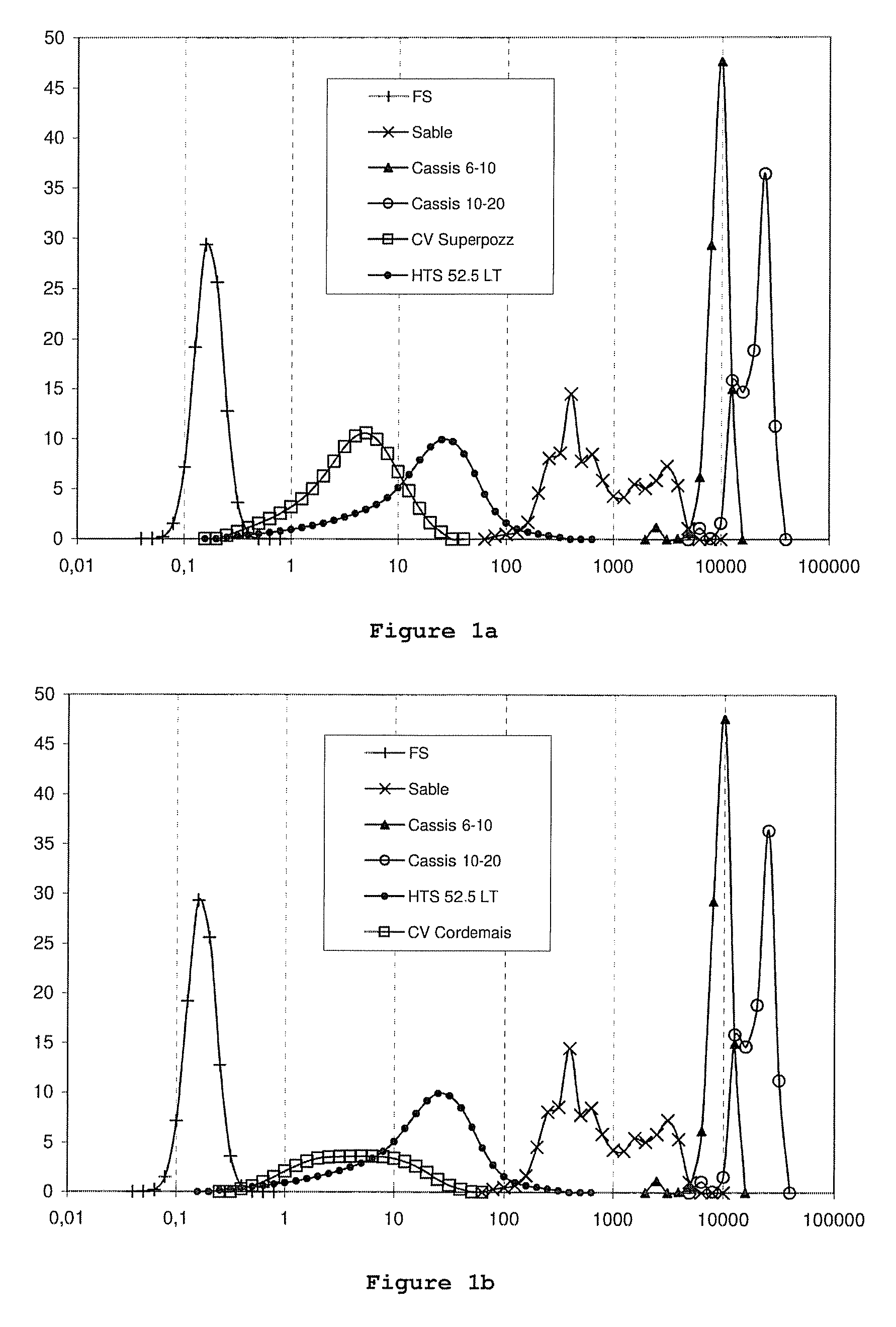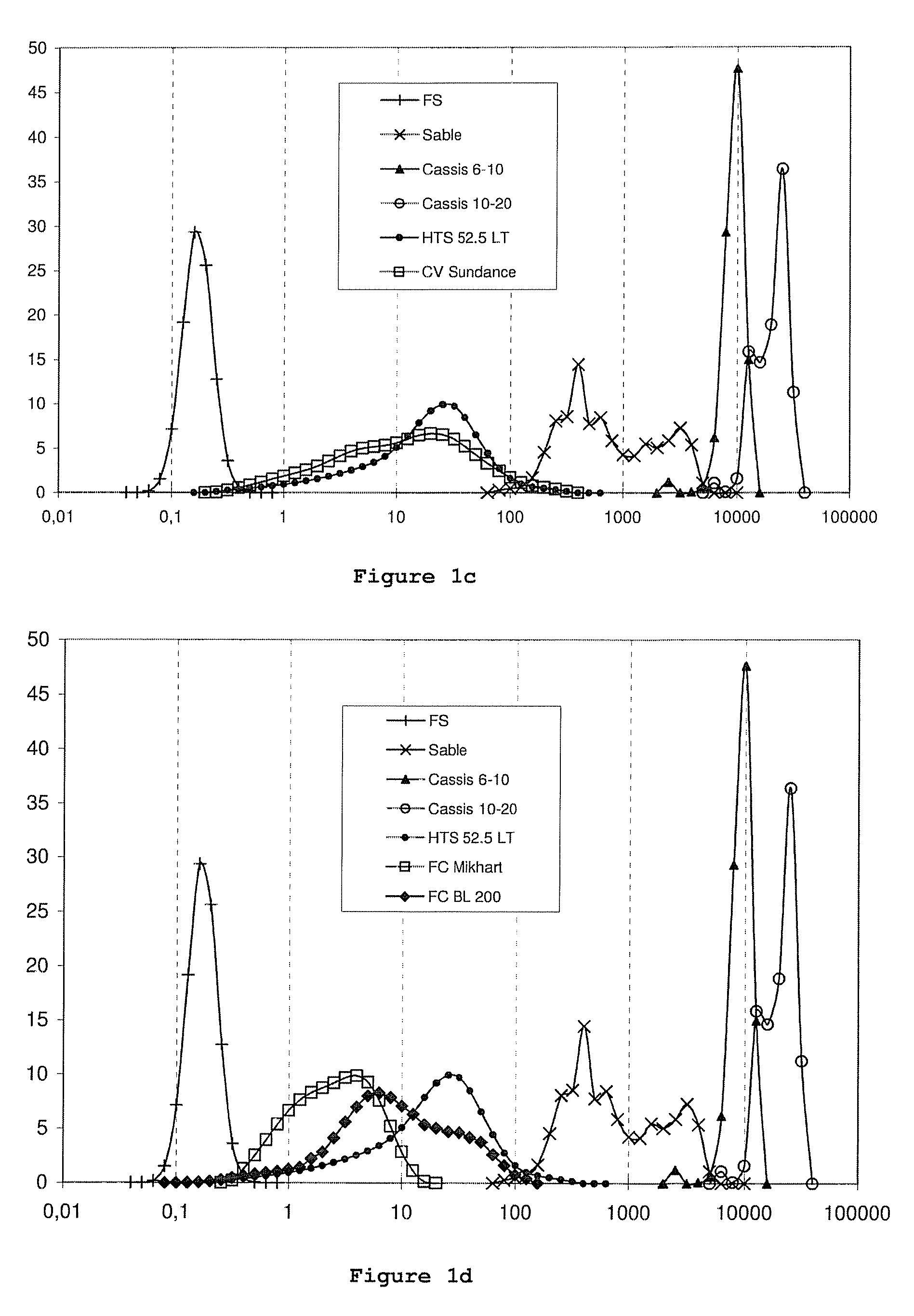Concrete with a Low Cement Content
- Summary
- Abstract
- Description
- Claims
- Application Information
AI Technical Summary
Benefits of technology
Problems solved by technology
Method used
Image
Examples
example 1
Laser Granulometry Method
[0197]The particle size curves of the different powders are obtained using a Malvern MS2000 laser granulometer. The measurement is carried out wet (aqueous medium); the particle size must be comprised between 0.02 μm and 2 mm. The light source is provided by a red He—Ne laser (632 nm) and a blue diode (466 nm). The Fraunhofer optical model is used, the calculation matrix is of the polydisperse type.
[0198]A measurement of background noise is first carried out with a pump speed of 2000 rpm, a stirrer speed of 800 rpm and a noise measurement over 10 s, in the absence of ultrasound. Then it is verified that the light intensity of the laser is at least equal to 80%, and that a decreasing exponential curve for the background noise is obtained. Otherwise, the cell lenses must be cleaned.
[0199]A first measurement is then carried out on the sample with the following parameters: pump speed 2000 rpm, stirrer speed 800 rpm, absence of ultrasound, obscuration limit betwe...
example 2
Method of Direct Visualization by Scanning Electron Microscopy
[0202]For powders with a strong tendency to agglomeration, the technique of direct visualization by scanning electron microscopy is used (with measurement and counting of the particles on the image obtained). Each powder sample is optionally dried by passing it through a drying cabinet at a temperature less than 50° C., or under vacuum or by lyophilization. Then two alternative methods for preparing the sample are used: preparation on adhesive tape for observing the powder overall (agglomeration effect, etc.) and preparation in suspension for individually characterizing the particles (size, shape, surface aspect, etc.)
[0203]In the preparation on adhesive tape, a metal block is taken and a double-sided self-adhesive conductive patch or double-sided self adhesive conductive tape is placed on its upper surface. Using a spatula, the powder to be examined is sprinkled on this surface, paying attention to the electrostatic effe...
example 3
BET Specific Surface Area Measurement Method
[0206]The specific surface area of the different powders is measured as follows. A sample of powder of the following mass is taken: 0.1 to 0.2 g for an estimated specific surface area of more than 30 m2 / g; 0.3 g for an estimated specific surface area of 10-30 m2 / g; 1 g for an estimated specific surface area of 3-10 m2 / g; 1.5 g for an estimated specific surface area of 2-3 m2 / g; 2 g for an estimated specific surface area of 1.5-2 m2 / g; 3 g for an estimated specific surface area of 1-1.5 m2 / g.
[0207]A cell of 3 cm3 or 9 cm3 is used depending on the volume of the sample. The measurement cell assembly is weighed (cell+glass rod). Then the sample is added to the cell: the product must not be less than one millimetre from the top of the throat of the cell. The assembly is weighed (cell+glass rod+sample). The measurement cell is placed on a degassing unit and the sample is degassed. Degassing parameters are 30 min / 45° C. for Portland cement, gypsu...
PUM
| Property | Measurement | Unit |
|---|---|---|
| Fraction | aaaaa | aaaaa |
| Fraction | aaaaa | aaaaa |
| Fraction | aaaaa | aaaaa |
Abstract
Description
Claims
Application Information
 Login to View More
Login to View More - R&D
- Intellectual Property
- Life Sciences
- Materials
- Tech Scout
- Unparalleled Data Quality
- Higher Quality Content
- 60% Fewer Hallucinations
Browse by: Latest US Patents, China's latest patents, Technical Efficacy Thesaurus, Application Domain, Technology Topic, Popular Technical Reports.
© 2025 PatSnap. All rights reserved.Legal|Privacy policy|Modern Slavery Act Transparency Statement|Sitemap|About US| Contact US: help@patsnap.com



